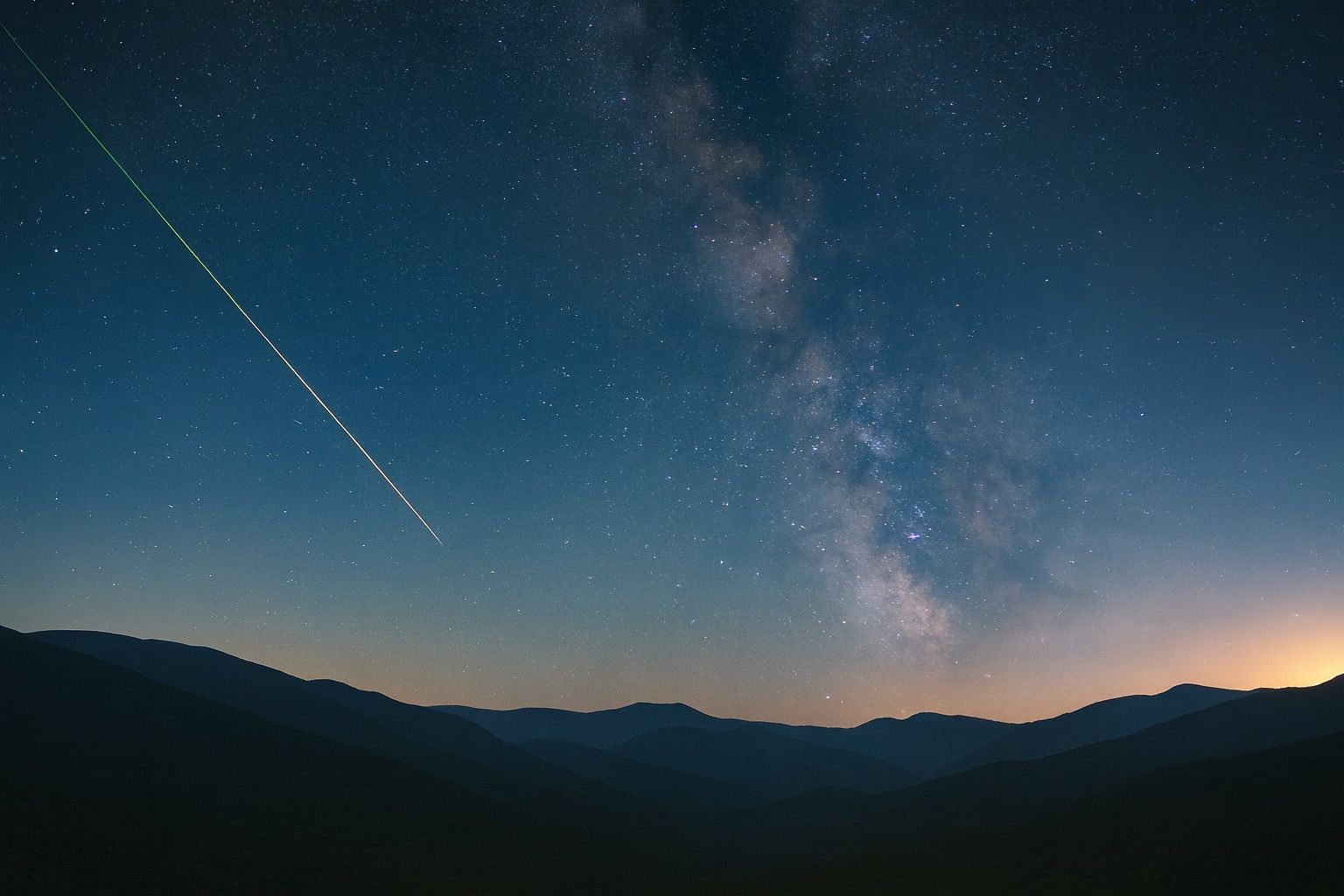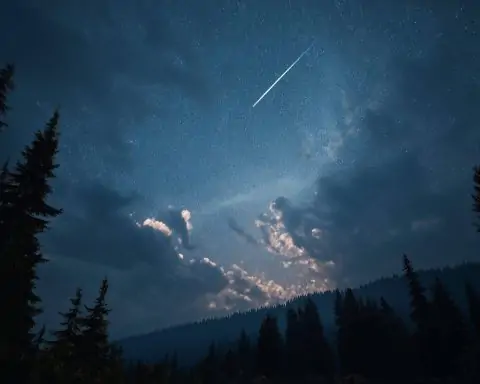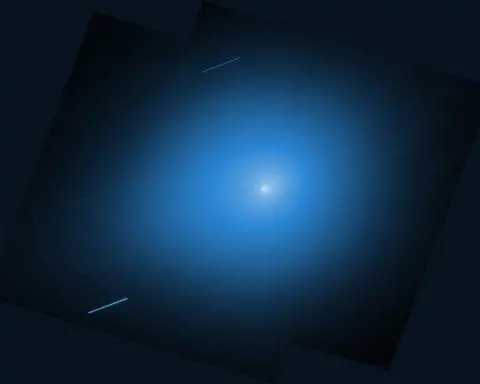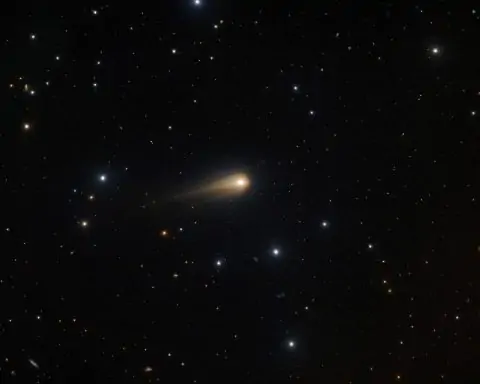- When & What: The Draconid meteor shower – active October 6–10 – peaks on the evening of October 8, 2025. This annual “Dragon” display usually offers only a handful of slow-moving meteors per hour [1]. It is a minor shower under normal circumstances, though it has the potential for dramatic surprises in rare years [2].
- Moonlight Interference: This year’s peak comes just two days after a full Harvest Supermoon on October 6. The near-full moon will dramatically wash out all but the brightest shooting stars [3]. NASA jokingly noted that if you don’t catch any Draconids, “you can always blame the bright supermoon” lighting up the sky [4]. Under the moonlight, observers might see as few as ~2–6 meteors per hour, according to forecasts [5].
- Outburst vs. Storm Potential: The Draconids are famously unpredictable – most years see ~5–10 meteors per hour [6] [7], but occasionally “the Dragon” awakens. Meteor outbursts of hundreds per hour have occurred (most recently in 2011, with 600+ meteors/hour observed in Europe [8]), and true meteor storms of over 1,000 per hour were recorded in 1933 and 1946 [9]. In 2025, some scientists predicted a significant outburst due to the parent comet’s recent close approach to the sun [10]. However, any surge may consist largely of faint meteors and could occur during daylight in North America/Europe, meaning casual skywatchers are unlikely to witness a storm [11] [12].
- Best Way to Watch: Unlike most meteor showers, the Draconids are an evening spectacle. Their radiant (in the constellation Draco the Dragon) is highest just after nightfall [13] [14], so the best time to look is in the early evening on Oct. 8, as soon as darkness falls. Face the northern sky and get to a dark location away from city lights. Try to block the Moon’s glare (e.g. hide it behind a building, hill, or tree) to improve your chances of spotting meteors [15] [16]. Allow ~20–30 minutes for your eyes to adapt to the dark, and be patient – the shower’s peak activity window is brief, only a few hours long [17].
- What’s Next: If the Draconids end up a dud, don’t fret – autumn has other sky shows. The Orionid meteor shower (from Halley’s Comet debris) will peak on October 21–22, 2025 under ideal moonless conditions (the new moon falls on Oct. 21) [18]. Skywatchers can expect roughly 15–20 fast meteors per hour at the Orionid peak [19]. Additionally, two comets will visit the October skies: long-period Comet C/2025 A6 (Lemmon) and newly discovered Comet C/2025 R2 (SWAN) both make their closest approach around late October and could brighten to binocular visibility or even faint naked-eye levels in very dark skies [20].
The Draconids: A “Dragon” in the Night Sky
Every October, the Draconid meteor shower gives skywatchers a chance – however slim – to see fireballs from the Dragon. The Draconids occur when Earth passes through dust debris shed by Comet 21P/Giacobini–Zinner, a small periodic comet that orbits the sun every 6.6 years [21]. As these cometary bits hit Earth’s atmosphere at a relatively languid pace, they burn up and streak across the sky as meteors (often called “shooting stars”) [22]. The Draconids take their name from the constellation Draco, from which the meteors appear to radiate. Because Draco is a northern constellation (its “head” near the dragon’s eyes Eltanin and Rastaban), the Draconid shower is best viewed from the Northern Hemisphere [23] [24]. Southern Hemisphere observers see little to none of this display, since Draco lies low or below the horizon for them in the evening.
What makes the Draconids especially interesting is their timing. Unlike most meteor showers that are strongest after midnight or in pre-dawn hours, the Draconids are an early evening show [25] [26]. As soon as darkness falls on the peak night, Draco’s radiant is high in the sky, and meteors may begin flitting overhead. This means you don’t have to stay up late or wake at an odd hour – a rare treat for casual stargazers. “The Draconids are a very quick shower,” explains Robert Lunsford, fireball report coordinator for the American Meteor Society. “We on Earth pass through debris (from the comet 21P/Giacobini-Zinner) in just a few days, and the main maximum (activity) actually only lasts a few hours. So it’s here and gone just like that” [27]. In other words, the peak of activity is brief – essentially one evening – so plan to be outside during nightfall on October 8 if weather permits.
What to Expect for the 2025 Peak
This year, skywatchers have been eager yet cautious about the Draconids’ prospects. On one hand, 2025 has some intriguing factors that raised hopes for an enhanced show. The comet that spawns the Draconids, 21P/Giacobini–Zinner, reached perihelion (its closest approach to the sun) in late March 2025 [28]. Around such perihelion years, Earth can encounter denser clumps of fresh debris in the comet’s trail, which sometimes leads to meteor outbursts or even storms. In fact, an international team of scientists – including NASA’s Meteoroid Environment Office – predicted 2025 could be an “outburst year” for the Draconids [29]. Their modeling suggests Earth will plow through dust streams emitted by the comet in 2005 and 2012, potentially producing a surge of meteors [30]. Every few decades the Draconids have surprised observers with meteoric extravaganzas, so the question naturally arose: Will the Dragon awaken in 2025?
Unfortunately, nature has thrown a wet blanket on those fiery dreams – in the form of a brilliant Moon. The Draconid peak is arriving just 48 hours after October’s full Harvest Supermoon, meaning the Moon is still ~93% illuminated on the night of October 8–9 [31] [32]. Such a bright sky can drown out most meteors, especially the Draconids which tend to be on the faint side. NASA’s skywatching advisory dryly noted that if you fail to spot any meteors, you can “blame the bright supermoon” this week [33]. In practical terms, even if an outburst of Draconid meteors occurs, many could be too faint to see through the moonlight glare. Experts estimate that under these suboptimal conditions, an observer might only catch on the order of a few meteors per hour at best [34] – a far cry from a storm.
There’s also the matter of timing. The predicted peak of the Draconid shower in 2025 was around 19:00 UTC on Oct. 8(3 p.m. Eastern Time) [35] [36]. That peak timing would fall during daylight hours for North America and much of Europe, making the initial burst invisible to those regions. If a meteor outburst did occur at that time, it would likely favor parts of Asia after nightfall [37] [38]. Some scientists suspect any outburst might be dominated by very small meteors (detectable by radar but hard to see with the naked eye) [39]. In short, while it’s wise to keep an eye out – the Draconids are known for tossing the occasional curveball – expectations should be tempered this year. “This shower is usually a sleeper… but watch out if the Dragon awakes!” one astronomy writer notes [40]. It’s that slim chance of a surprise dragon roar that keeps veteran skywatchers outside, even under moonlit skies [41].
Skywatching Tips to Maximize Your Viewing
If you’re determined to try your luck with the Draconids, a few strategies can improve your experience. First, pick the right time: aim for the early evening of October 8, shortly after your local sunset as the sky gets fully dark [42]. Unlike many showers, there’s no advantage to waiting until midnight or dawn for the Draconids – you actually want to catch them in the evening before the radiant sinks lower later at night [43].
Next, find a dark observing site. Get as far from city light pollution as possible; even a local park or a backyard with minimal lights will help. Once outside, give your eyes time to adjust (about 20 minutes of no bright light exposure). The Draconid meteors can appear anywhere in the sky, but since their radiant is in the north, it’s wise to face north or northwest and keep an expansive view of the heavens [44]. You don’t need a telescope or binoculars – meteors are best seen with the naked eye, since they streak across wide portions of the sky.
Dealing with the Moon is the biggest challenge in 2025. Try to position yourself such that the Moon is blocked by an obstacle – for example, situate yourself on the north side of a building or grove of trees, so that the Moon (which will be in the southern sky) is hidden behind them [45]. This can significantly improve your night vision. As one guide suggests, even a raised hand or a strategic tree branch can shield your eyes from the Moon’s direct glare, much like blocking a bright streetlamp [46] [47]. The darker your surroundings, the better your odds of spotting the faint streaks.
Bring a comfy chair or blanket to lie back on – Draconid meteors are often slow and may take a while to appear, so patience is key. And while only a modest show (~10 meteors/hour under ideal dark skies) is expected this time [48] [49], remember that meteor watching is as much about the experience as the numbers. Even one bright fireball racing across the stars can make your night.
A History of Dragon Fireworks: From Fizzles to Fury
Why all the buzz around a shower that most years barely sputters? The Draconids have earned a reputation as a wild cardin the meteor world. Usually, they produce “only a smattering of meteors” and many observers might not bother under a bright moon [50]. But on rare occasions, this gentle drizzle has turned into a downpour. In October 1933 and 1946, during the comet’s return, the Draconids unleashed thousands of meteors per hour, astounding those lucky enough to witness the spectacle [51]. Reports from 1946 described the meteors “falling like rain” across the sky [52] – a true meteor storm by definition. Imagine the sky filled with streaks of light, sometimes dozens visible at any given moment.
More recently, “Dragon” outbursts have been observed on a smaller scale. In 2011, observers in Europe were treated to an outburst of over 600 meteors per hour at the peak [53]. In 2018, when Comet Giacobini-Zinner made an unusually close pass by Earth, the Draconids also showed a noticeable uptick in activity (though nothing like the mid-20th-century storms) [54] [55]. These episodes tend to occur when Earth intersects particularly dense filaments of debris that had been shed by the comet in recent decades. They are difficult to predict precisely – different meteor forecasters’ models sometimes disagree on if or when a burst will occur [56]. That unpredictability is part of the excitement: most years the Dragon sleeps, but any given year it might wake up breathing fire.
For 2025, as noted, scientists identified some young dust trails that Earth would meet, suggesting a possible outburst(one paper projected a “significant outburst” based on those models [57]). Crucially, they also noted the peak would likely occur over Asia due to time zones [58]. Indeed, the Patch news site reported that if a daytime outburst hit, it could “favor early evening viewing conditions” in Asia once night falls [59] [60]. However, given the almost full Moon and the possibility that many meteors could be very faint, even an outburst might go largely unnoticed by human eyes. In essence, the Dragon may roar where no one sees it, except perhaps on scientists’ radar screens. It’s a reminder that meteor showers involve tiny cosmic grains – some only the size of sand – and their visibility depends on both celestial timing and earthly conditions.
Meteor experts like Robert Lunsford emphasize that the Draconids’ charm lies in their convenience and curiosity rather than sheer numbers. “The Draconids are… here and gone just like that,” Lunsford said, highlighting how short-lived the peak is [61]. But he and others still encourage die-hard meteor watchers to give it a try – especially because if the Dragon does spring a surprise, you won’t want to miss it. As EarthSky.org notes, the mere possibility of witnessing the Dragon’s fiery breath “keeps many skywatchers outside – even in moonlight – during this shower” [62].
After the Draconids: More Celestial Delights on the Way
Whether the Draconids sizzle or fizzle this year, the night sky has plenty more in store as October continues. The next major meteor shower, the Orionids, will peak on the night of October 21–22, 2025. The Orionids are fragments of the famous Halley’s Comet that Earth plows through each fall. This year, timing is on our side: the Moon will be a thin new moon (virtually absent from the sky) on those dates, providing dark viewing conditions [63]. Under moonless skies, the Orionids can produce around 15–20 meteors per hour, and occasionally some brilliant fast fireballs [64] [65]. These meteors are known for their speed – hitting our atmosphere at nearly 148,000 mph – which often creates long-lasting trains of ionized gas that linger after the meteor streaks by [66]. If you missed the Draconids or found them underwhelming, the Orionids will be a more reliable show later this month [67].
October 2025 also brings a rare treat for comet enthusiasts. Two comets will be gracing the night sky simultaneously in late October. Comet C/2025 A6 (Lemmon) is swinging through the inner solar system and reaches its closest point to Earth around October 21 [68]. Around the same time, Comet C/2025 R2 (SWAN) – a newly discovered visitor – makes its nearest pass on October 21 as well, at about 25 million miles away [69]. Both comets are expected to hover near the threshold of naked-eye visibility (approximately magnitude 6–7) under dark skies [70]. In practice, that means you’ll likely need binoculars or a telescope to spot them, unless you’re in a very dark location. Still, the prospect of catching two comets on the same night has astronomers buzzing – in fact, some stargazing guides are calling October 24, 2025 the “night of the two comets,” when both might be sighted in different parts of the sky [71]. If you’ve never seen a comet before, this month offers a chance to tick that off your bucket list.
As a final cherry on top of this cosmic sundae, nature might even throw in some auroras. In early October 2025, the sun was active enough to launch a couple of coronal mass ejections (solar eruptions) toward Earth. Space weather forecasters issued a geomagnetic storm watch for October 8, expecting minor G1-class auroras and possibly stronger at high latitudes [72] [73]. There was hope that observers in northern-tier U.S. states, Canada, and northern Europe might glimpse the ethereal green glow of the Northern Lights on the same night the Draconids peaked [74]. However, much like the meteors, the bright Moon posed a challenge for aurora visibility, likely subduing the spectacle for all but the most active displays [75] [76]. Still, it’s noteworthy that on the night of October 8–9, skywatchers had a veritable feast of celestial phenomena potentially on tap – from auroras dancing near the horizon to dragons flinging fireballs overhead, all under the gaze of a brilliant Harvest Moon.
Conclusion
The Draconid meteor shower of 2025 may not end up being the “most exciting meteor shower of the year” despite some hopeful buzz. The odds are that the dragon’s treasure will be largely stolen by the Moon this time. But even a quiet meteor night has its rewards. Standing under the stars on an crisp autumn evening, you might catch a slow ember of a meteor slip across the sky – a reminder of our planet’s journey through the dusty trails of an ancient comet. And there’s always that tiny chance, as history has shown, that the Dragon could roar when least expected, unleashing a flurry of celestial sparks.
Either way, the Draconids offer a perfect excuse to look up and wonder. As one observer noted, the Draconids’ appeal is partly in their mystery: probably not much will happen… but you never know [77] [78]. So grab a jacket, head outside after sunset, and watch the northern skies. If luck is on your side, you’ll witness a dragon’s breath in the heavens. And if not, fret not – the cosmos has many more shows on the schedule. In the coming nights and weeks, keep watching for Orion’s swift meteors and maybe even the ghostly glow of twin comets paying us a visit. The universe always has another surprise around the corner for those who keep their eyes on the skies.
Sources: The above information is compiled from NASA and NOAA advisories, astronomy experts, and media reports [79] [80] [81] [82], including insights from EarthSky, CNN, FOX Weather, Travel+Leisure, Patch, and Tech Space 2.0 (TS2) news [83] [84] [85] [86]. These sources include expert commentary from the American Meteor Society and NASA researchers, as well as historical observations of past Draconid meteor storms. All evidence points to a modest Draconid display in 2025 – but with this quirky shower, eyes to the sky is always the best policy, just in case.
References
1. ts2.tech, 2. ts2.tech, 3. ts2.tech, 4. ts2.tech, 5. ts2.tech, 6. ts2.tech, 7. earthsky.org, 8. www.foxweather.com, 9. www.foxweather.com, 10. www.travelandleisure.com, 11. patch.com, 12. patch.com, 13. ts2.tech, 14. www.foxweather.com, 15. ts2.tech, 16. www.reddit.com, 17. www.reddit.com, 18. ts2.tech, 19. ts2.tech, 20. ts2.tech, 21. ts2.tech, 22. ts2.tech, 23. earthsky.org, 24. www.foxweather.com, 25. ts2.tech, 26. www.foxweather.com, 27. www.reddit.com, 28. www.foxweather.com, 29. patch.com, 30. arxiv.org, 31. ts2.tech, 32. ts2.tech, 33. ts2.tech, 34. ts2.tech, 35. www.reddit.com, 36. earthsky.org, 37. patch.com, 38. patch.com, 39. www.facebook.com, 40. earthsky.org, 41. earthsky.org, 42. earthsky.org, 43. ts2.tech, 44. www.reddit.com, 45. ts2.tech, 46. www.travelandleisure.com, 47. www.travelandleisure.com, 48. ts2.tech, 49. earthsky.org, 50. patch.com, 51. www.foxweather.com, 52. www.travelandleisure.com, 53. www.foxweather.com, 54. earthsky.org, 55. patch.com, 56. patch.com, 57. www.travelandleisure.com, 58. patch.com, 59. patch.com, 60. patch.com, 61. www.reddit.com, 62. earthsky.org, 63. ts2.tech, 64. ts2.tech, 65. www.astromark.org, 66. patch.com, 67. www.foxweather.com, 68. ts2.tech, 69. ts2.tech, 70. ts2.tech, 71. www.astromark.org, 72. ts2.tech, 73. ts2.tech, 74. ts2.tech, 75. ts2.tech, 76. ts2.tech, 77. earthsky.org, 78. earthsky.org, 79. ts2.tech, 80. www.reddit.com, 81. www.foxweather.com, 82. www.travelandleisure.com, 83. earthsky.org, 84. www.foxweather.com, 85. patch.com, 86. ts2.tech










